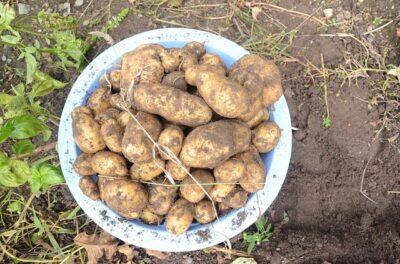Image source: Pixabay.com
The cultivation of potatoes originated in South America, where the Incas of Peru grew them for food some 10,000 years ago.
The original potato, though, bore little resemblance to today’s enormous, oblong, white-fleshed tuber. Instead, they were round, smaller than a golf ball, and dark blue in color.
When the Conquistadors conquered the Andes region of South America in the 16th century, they brought potatoes back to Europe. Basques in northern Spain immediately began growing them, and over the next 50 years cultivation spread throughout Europe. Potatoes were filled with vitamins and easy to grow, and many Europeans began growing them instead of the traditional crops of wheat and oats.
Today, the potato is the world’s fourth most grown crop, trailing only rice, wheat and corn. But potatoes are not restricted to large-scale farming — they are also an ideal crop for your garden because they are easy to grow, provide many calories per acre, and are adaptable to a variety of climates.
Looking For Non-GMO Potatoes? Look No Further!
But to maximize success, you should choose the right potato for your needs and growing conditions.
Cooking
Although there are potatoes for general use, different cultivars generally are better for a specific type of cooking. Some are good for boiling and mashing, others are good for baking, and still others are best fried.
The color of the potato flesh can be a good indicator which cooking method is best. For example, red or pink potatoes are often lower in starch, and therefore lend themselves to boiling or steaming. Common cultivars include red LaSoda and red gold.
Russet potatoes and those with blue flesh have higher starch. This makes them a good choice for baking or mashing. Potatoes with a thin white skin make great French fries (with the skin left on).
Yellow-fleshed potatoes tend generally to have intermediate amounts of starch and are good for all uses. Common cultivars include Cal white, Yukon gold, and Yukon gem.
Storage
For generations, Americans in cold areas have grown potatoes and stored them through much of the long winter. If your goal is to grow potatoes during a short summer season and then store the harvest in a cellar over the winter, then remember that not all potatoes store well. So look for cultivars that excel in long-term storage. Examples include Cal white, defender, red Gold and the russet varieties.
Heat Tolerance
Potatoes are a cool-weather crop, first proliferating in the high-altitude of the Andes and then excelling in the cool climates of Ireland and northern Europe. However, over time, much hard work and research has resulted in a few cultivars that can be successfully grown in hot climates. These include bake king, defender, red LaSoda, Viking purple and yellow Finn.
Maturity
Potatoes vary greatly in the time it takes to grow to maturity, from early to medium to late to extra-late. Based on your climate and needs, select the right maturity time. For example, on my homestead I grow an early cultivar and an extra-late cultivar.
Seamazing: The Low-Cost Way To Re-mineralize Your Soil
I consume the small, poor storage, early maturing potatoes during the late summer and early fall. I harvest the late cultivars and use and store them over most of the winter.
Caging
Many potatoes can be grown vertically in containers or boxes. The potato seeds are planted about three inches deep. Then, when the plants emerge to a height of several inches, they are buried halfway with soil. After several more inches of growth, the plants are buried halfway again. This continues until the original potato seed is two or three feet deep, allowing potatoes to grow in all the additional soil.
However, caging works better with some cultivars than others. It works well for Butterfinger, defender, purple Peruvian and many others. Caging does not work well with some popular cultivars like bake king, French fingerling or Yukon gold. So if you plan on growing potatoes vertically, choose a cultivar amenable to this growing method.
Final thoughts
Potatoes are a mainstay on the homestead, and can be grown in most parts of the United States. However, based on your cooking methods, storage conditions and other factors, make sure and select the cultivars that best suit your needs and that will be successful in your garden.
link to source content: http://www.offthegridnews.com/survival-gardening-2/potatoes-which-varieties-store-the-longest-cook-the-best-and-grow-just-about-anywhere/


